Photo London Moves to a Redeveloped Olympia in 2026
FOMU – Fotomuseum Antwerp: An Interview with Tamara Berghmans, Curator of the Collections Department
Summer Sale of over 4,000 Photographs on I Photo Central at 30% Discount
Italy Reduces VAT on Art and Photography Sales to 5%
Human Rights Lawyer to Defend Artist Gao Zhen, as China Holds the Artist's 7-Year-Old American Son
Some Recommended Vendors that We Have Worked with.
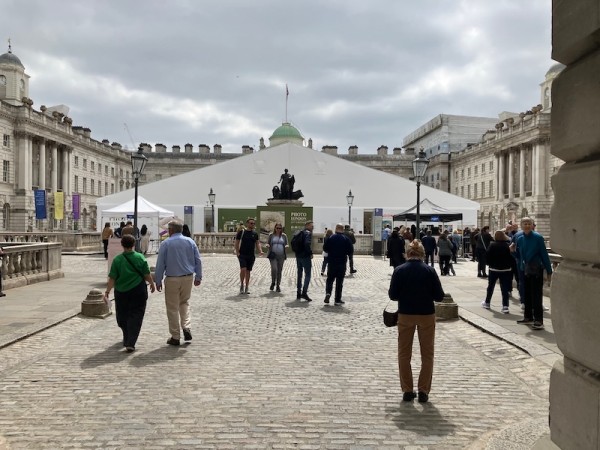
Photo London exterior view of the Pavilion.
This year, Candlestar, the promoter of Photo London, marked the 10th anniversary of the fair. It has been a bumpy ride, to say the least. Before Candlestar launched their fair, there was an earlier Photo London, started by Daniel Newburg in 2004. While the fair had good attendance, sales were less than satisfactory. The fair was taken over in November 2006 by Reed Exhibitions and was closed down by them following the 2007 edition, a strategy many thought, to eliminate a competitor to Paris Photo.
When Candlestar started up in 2015, it seemed to me that they fell into the same trap as Newburg had done, aiming for the cream of international photography galleries. It might have worked if London had had a strong base of photography collectors. Well, it never did and those leading galleries, including Hamiltons, Howard Greenberg, Edwynn Houk and others gave the fair a try and then bailed out.
Despite that, Photo London has soldiered on, meaning it has had to find its own direction in a market where the sand is constantly shifting. Add to that Brexit, a shaky art market, uncertainties over the world economy and a generational shift in the collector base.
One issue could and should have been dealt with. Every year, there's a rumor that Photo London will move to a more suitable fair venue (see next article about the show’s move to Olympia, at the heart of Kensington in 2026). Somerset House is charming but while the temporary pavilion in the courtyard gets a lot of traffic, the main building gets considerably less. Some visitors don't even bother to explore the upper and lower floors. It's their loss because I saw a lot of good work there.
There were significant improvements this year. Last year there were some real dips in the quality of the work that was shown. As I understand it, the selection committee was more critical this time. Even so, there was a late scramble to get good galleries to sign up. This year it brought in some 130 exhibitors, including publishers. And there were some exceptional presentations this year. Despite that, there are a great many who are dismissive of Photo London, as it doesn't have the same impressive lineup as Paris and New York, but I have always found interesting work at the fair.
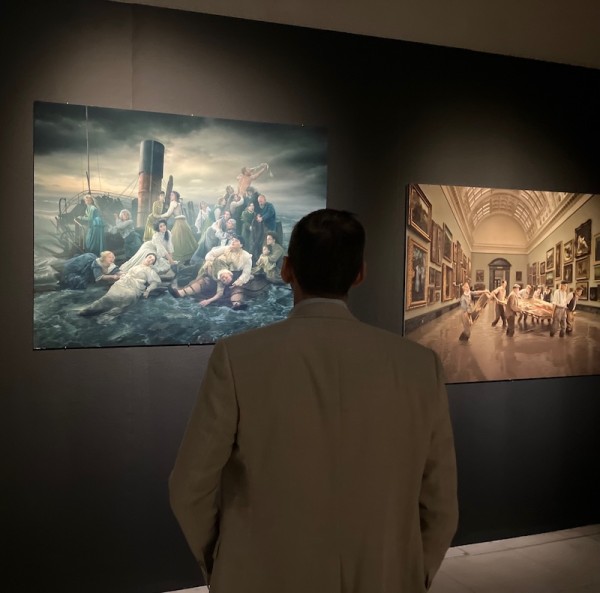
Works by Julia Fullerton-Batten, part of the exhibition London Lives.
And Photo London keeps changing. On the 10th of June last year, Candlestar announced that Kamiar Maleki was stepping down as Director of the fair, with Sophie Parker, Associate Director, its first female Director, taking over the reins. She has implemented several changes. Photo London's prize, Master of Photography, among the recipients, Edward Burtynsky, Martin Parr and Valerie Belin, is now a thing of the past, and the concept did feel somewhat antiquated.
The winners were presented in a large exhibition in half of the large hall downstairs in Somerset House. This year, the whole exhibition space was given over to a large group exhibition curated by Francis Hodgson called “London Lives”, with works by Nick Knight, Julia Fullerton Batten, David Bailey, Nadav Kander and others.
Another section downstairs, “Positions”, launched last year, featured artists without representation, put forward by the fair's Supporters' Circle and curated by Maria Sukkar, and I was particularly impressed by the work of Egyptian artist Karim El Hayawan. But the big change for me was the “Discovery” section, curated by Charlotte Jansen. This time it lived up to its name with high-quality work on the stands.
I started in the West Wing and my first stop was the room of Robert Hershkowitz, Cockhaise, whose presentation was one of the highlights of the fair, with exquisite prints by Linnaeus Tripe, Duchenne de Boulogne, Dijon, Francis Frith and others. A section was devoted to images of London, the official theme of the fair this year, with images by Fox Talbot and Frederick Evans. In addition, there was a selection of industrial images by Walter and Rita Nurnberg.
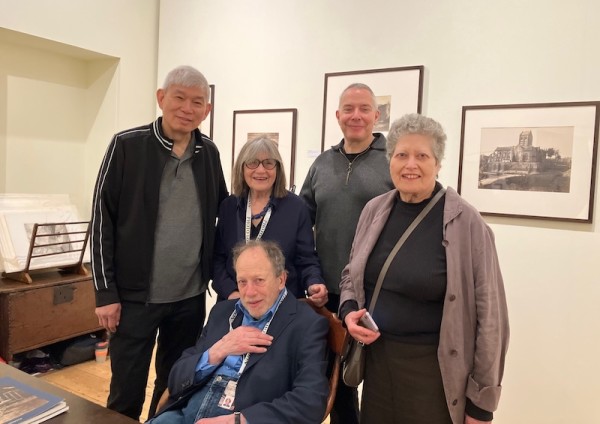
Robert and Paul Hershkowitz with photography duo Anderson & Lowe and Daniella Dangoor.
Hershkowitz told me, "We have had a very good reception to our presentation, and we have had some very good sales as well. We sold an important Francis Frith, a couple of Frederick Fiebig prints, a Charles Nègre, an André Giroux, a Roger Fenton and a Charles Weed. We also have serious interest in a Duchenne du Boulogne. This year, we also brought industrial photography by Walter Nurnberg, whose cinematographic lighting techniques created dramatic scenes of British factory life in the 1940s. It's unusual work for us to show, very reasonably priced, and we are waiting for a decision on them. Overall, we have done much better at Photo London than in previous years, which surprised us. We have also seen more museum people this year, not just from the UK but also from Europe."
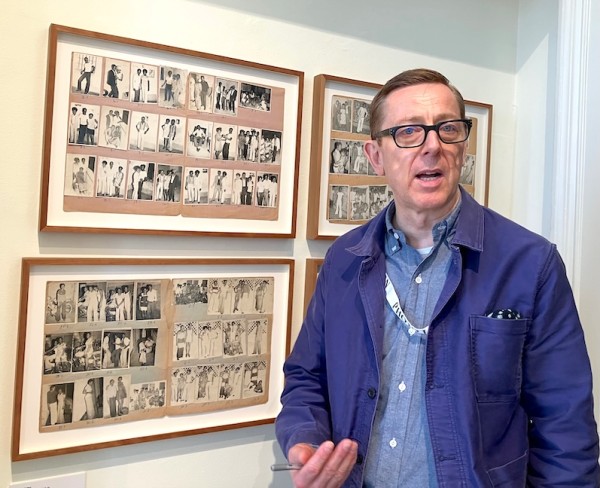
David Hill
In the large room next door, David Hill Gallery, London, was showing an impressive group show. Hill told me, "The West Wing has more of a vintage or classic identity so I'm showing works by Baldwin Lee, Larry Fink, Kathy Shorr, Marc Riboud, Malick Sidibé as well as more recent work by Alice Mann and Kyle Weeks. I have shown at Photo London before but this is the first time since COVID, and I'm very pleased to be here. It has been a really good fair for me. Lots of great people coming through, lots of interest in the work, good sales. The PR team has done an excellent job of promoting the fair."
Many visitors were drawn to the corner of the large room where Hill was exhibiting rare works by Malick Sidibé. "We represent Sanlé Sory, a photographer from Burkina Faso and he lives close to Bobo Dioulasso, the old cultural capital of the country. The person who discovered Sanlé Sory outside of the local context was Florent Mazzoleni, a specialist in West African music and culture. He knows the Sidibé family. In 2017, he met with the family and bought 25 chemises, file sheets with contact prints. I bought half of them and we are showing the last four we have. They're pretty special things, totally unique. They have certainly drawn people here. The response to the presentation has been great, and I have achieved very good sales so I'm pleased."
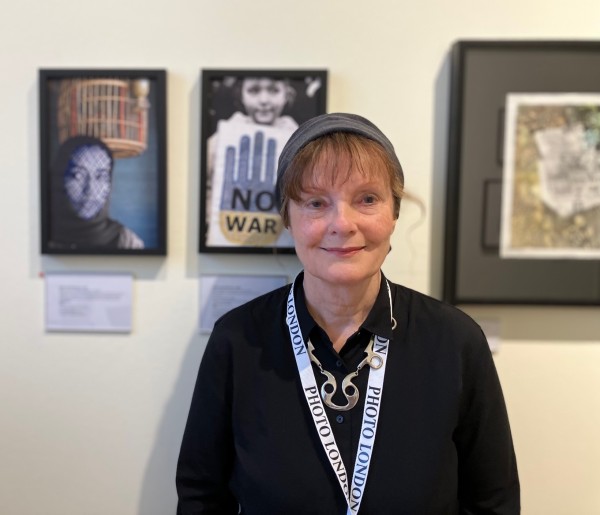
Jane England of England & Co, London.
England & Co, London, focuses on conceptual and performance-related work from the 60s up until the 80s, but was showing a more varied selection of works this year. Jane England told me, "We signed up for the fair very late in the day so we didn't have a planned curatorial project. The idea was to create a cabinet room or a salon, with work by Anne Bean, James Collins, Susan Hiller, David Thorp, Li Yuan-chia, Silvia Zirane and others, as well as works by Bill Brandt, Sarah Moon and Man Ray. In addition, we brought works by Jenny Matthews. She's a documentary photographer, now in her late 70s and has worked in Sudan, Afghanistan and many other places. She went to Afghanistan between the Taliban being in power and was terribly upset about what had happened to the women there. She revisited some of her images, also images of protests against the war in Ukraine, printed them on linen, embroidered them, making new statements. The fair has been good this year and we have had decent sales and also some interest from museums and institutions."
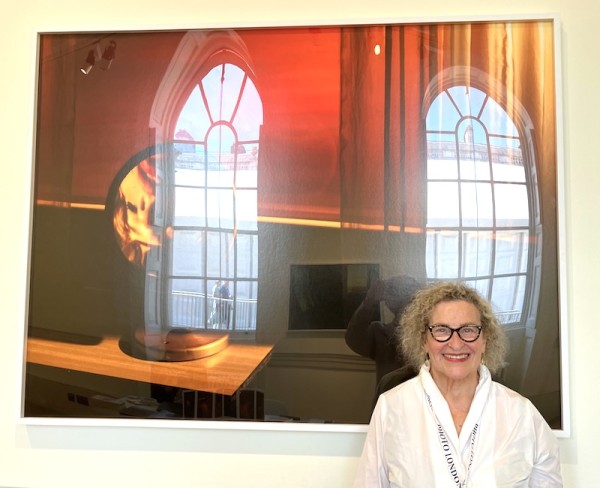
Rose Shoshana, Rose Gallery, Santa Monica.
There were contemporary works as well in the West Wing. Rose Gallery, Santa Monica, was showing a solo show with Tania Franco Klein. It was very impressive as staged photography with a cinematic feel has been an overpopulated, not to say cliché-ridden genre in the last 20 years. And because of that, the work by Tania Franco Klein was all the more impressive, having succeeded in creating gripping imagery.
Rose Shoshana told me, "It's an interesting circle because in 2022, Tania received the Emerging Artist Award from Photo London. We are showing selections from three bodies of work by her. They are different but they also connect. She sees things in her own unique way. She doesn't start with a concept but puts herself in different situations, and though the photographs are staged, she always improvises. There are no specific narratives, so they have a special enigmatic feel with several levels of meaning, and for the viewers, levels of interpretation. I have heard so many different kinds of comments about them here at the fair. It has worked well, and I'm pleased with the sales we have achieved."
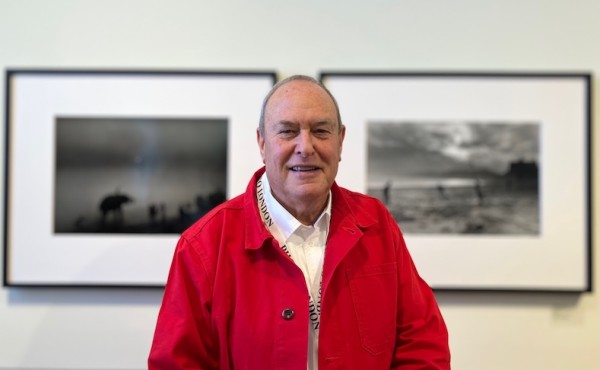
Peter Fetterman, Santa Monica.
Further down in the West Wing, Peter Fetterman Gallery, Santa Monica, was showing works by Jeffrey Conley, O. Winston Link, Paul Cupido, Don McCullin and Ormond Gigli. I asked Fetterman about sales and he told me, "It's been pretty tough, but it's tough everywhere because of the global economic prospects. And Trump USA is causing chaos in many markets. The great material, however, will always be in demand, and I think we have a beautiful display of great material so I'm not anxious. Obviously, we would like to leave London with lots of checks, but sometimes, and especially with London, it's always a slow burn. We often hear back from people three months after the fair, sometimes six months later."
Fetterman continued, "AIPAD was a tough show for us. This business is not like other businesses. It's about how you connect with people and hopefully have them plug into your taste, that they believe in what you believe in. It's very personal, the relationship between a gallery and a collector.
"It's not a rational business. In fact, it's not a business. It's a passion. But us crazy people have to do this. I'm Billy Graham, an evangelist for photography, and that's what gets me out of bed in the morning. Still, I think I'm going to take a little break from fairs, just isolate myself, and work on the three books I have planned."
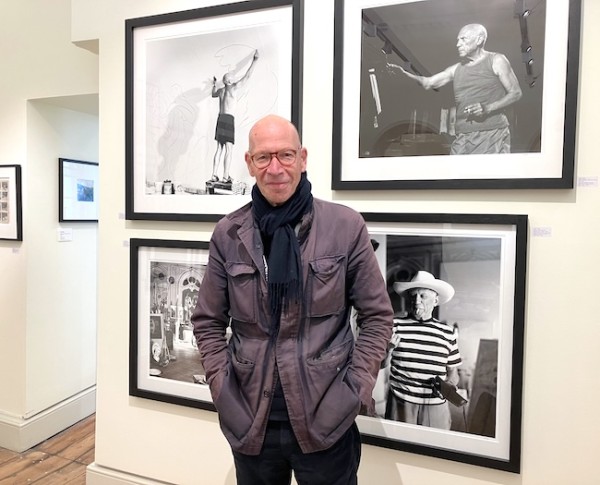
Mart Engelen of Suite 59 Gallery, Amsterdam.
In the East Wing, Suite 59 Gallery, Amsterdam, was showing classic black and white images by Gilles Caron, Edward Quinn, Griet Van Malderen, Andre Villers, Ernst Scheidegger, Donata Wenders and gallerist Mart Engelen himself.
Engelen told me, "When my wife and I started the gallery in 2008, we agreed on one thing: we wanted to promote the appreciation and collecting of black and white images, and that's what we still do. Photo London is celebrating its 10th anniversary this year and that made it special. There were many visitors and the atmosphere was very good. Somerset House is a fabulous building to show art. I noticed this year that more and more young, new galleries like to show works of artists who present less and less real photography in their works. I saw one booth which was showing practically only paintings. They tend to forget that the extraordinary thing about photography is that you can capture an amazing moment in a split second."
Engelen reported good sales, "We were also pleasantly surprised that we sold to many young collectors this year. We achieved good sales, but unfortunately, we also have to deal with the fact that art fairs become more and more expensive to do every year."
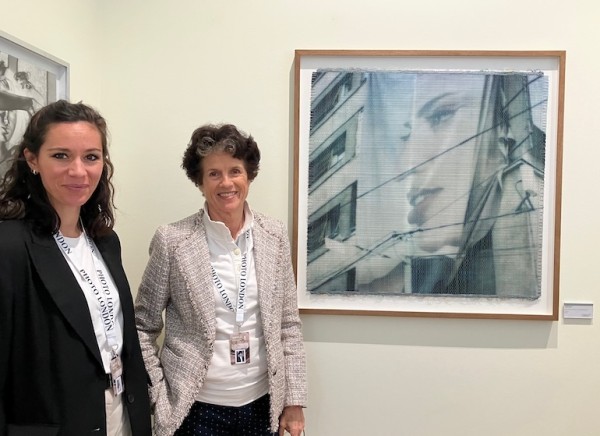
Galerie XII, Paris, Left, Camile Reynard, right, Valérie-Anne Giscard d’Estaing.
On the ground floor of the main building, Galerie XII, Paris, was showing works by Paolo Ventura, Mona Kuhn, Sophie Zénon, Patrizia Mussa and Susanne Wellm. The latter cropped up in many conversations that I had. Wellm uses a complex process, combining weaving with cotton and polyester thread, Giclée printing and acrylic paints. Valérie-Anne Giscard d'Estaing told me, "We showed at Photo London two years ago and decided to come back this year. Susanne Wellm is Danish and lives and works in Copenhagen. Each piece is unique and very time-consuming to make. She has a strong collector base in Denmark so we asked her to make a group of works especially for us. The ones we have shown here are the last ones, and we have done very well with them. We have sold works by Mona Kuhn as well, and I'm expecting decisions on more works. If they sell, we will make a good profit, if not, we will have covered our costs."
Giscard d'Estaing continued, "There were a lot of visitors coming through on the first day but since then it has been very, very quiet. The last day at Paris Photo is always packed, but not so here. I think they need to do a lot more to bring visitors to the fair."
Rolf Art, Buenos Aires, was showing upstairs in the main building, and I stopped by several times to see the works by Roberto Huarcaya, Santiago Porter and Julieta Tarraubella.
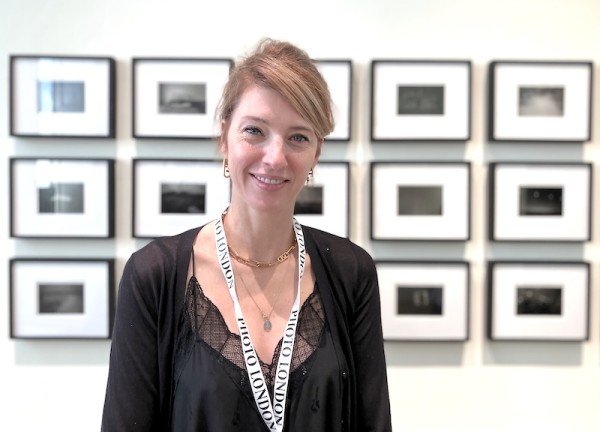
Florencia Giordana Braun of Rolf Art, Buenos Aires.
Florencia Giordana Braun told me, "We are showing early work by Santiago Porter. Later on, he moved into painting and then back to photography with this new series, "Where I have never been". In these works, he has painted his negatives with oil paint, and there are parallels with Gerhard Richter for example. We are showing one work by Roberto Huarcaya, part of his series "Amazogramas", large photograms made in the Amazon, as that we have shown at Paris Photo and the Venice Biennale. Julieta Tarraubella is the youngest artist we work with. She starts with digital images, continues with analog, creates photograms and then digitizes them. We have had a very good reception from many institutions and international visitors, and we have achieved very good sales. Still, Photo London needs to grow and improve but for me it's important to support the fair, because it's the only big fair in the UK that specializes in photography."
The pavilion was very well attended. Just a week before the fair, Atlas Gallery, London, and David Grob Gallery, Geneva, had finalized the purchase of the photography holdings of Marlborough Gallery, founded in London in 1946, which is in the process of dissolving. David Grob Gallery had taken a very large booth and showed a large selection of works by Bill Brandt and Brassaï, while Atlas Gallery showed a smaller selection.
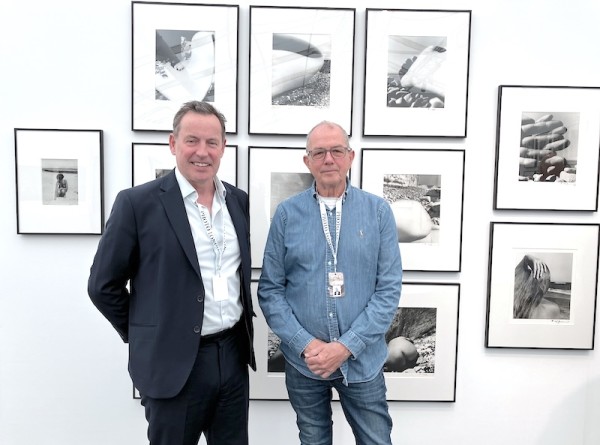
Ben Burdett of Atlas Gallery, London, and David Grob of Grob Gallery, Geneva.
Ben Burdett of Atlas Gallery told me, "It's an important acquisition for us, and in addition to works by Bill Brandt and Brassaï, there are also works by Berenice Abbott, Robert Frank, Helmut Newton and a few others. Earlier on, Marlborough had sold its holdings of works by Irving Penn but the rest of it was untouched. It was fascinating to look at all these great prints which were in perfect condition. The reception has been really great, while sales have been okay but not earth-shattering. I have spoken to other exhibitors at fair. Some have told me that sales had been poor, and I have spoken to others who were downright depressed."
Burdett was also showing works by George Hoyningen-Huene, William Klein, Richard Caldicott, Nan Goldin, Bastiaan Woudt and others. He continued, "I get the impression that AIPAD's The Photography Show is embracing contemporary photography more and more. The Photo London audience seems to be more focused on 20th-century classics, and it's certainly what we have done best with these last few years."
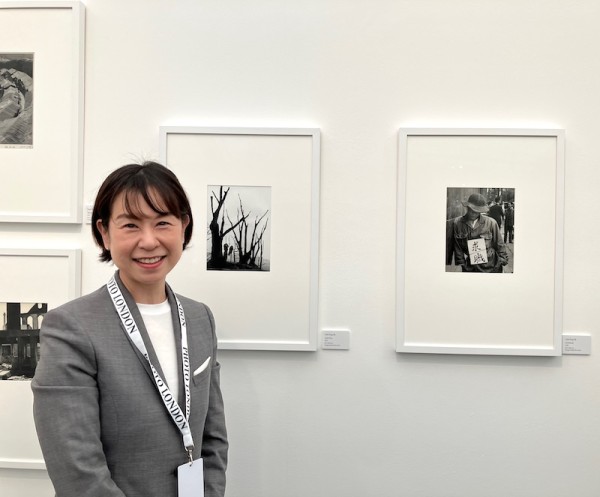
Bang Eun Kim of Gallery Yeh, Seoul.
Another stand that many talked about was that of Korean Gallery Yeh, Seoul. It showed works by two photographers, Eung Sik Limb (1912- 2001) and Kim Woo Young (born 1960). Director Bang Eun Kim told me, "It's the first time we exhibit at the fair. The atmosphere is very good and people have responded very positively. There has been a lot of interest, but it hasn't translated into sales. We have heard from others that the London audience takes time to decide, that many buy after the fair so we will see."
Kim continued, "Limb Eung Sik forms the first chapter of photography in Korea, and he is the godfather for those that followed. We have had quite a few museum curators coming through, not only from the UK but also from Europe. Plus, we now have serious interest from a major institution in the US that wants to buy Eung Sik Limb's archive. The Korean institutions already have major works by him in their collections, so it would be great if the archive went abroad, making him better known internationally."
James Hyman Gallery had one of the stand-out booths at the fair, despite signing up just a few weeks prior. The emphasis was on 20th-century classic photography. Hyman told me, "In common with Paris Photo and AIPAD, the emphasis at Photo London is more and more on contemporary work and I'm very keen that people should see a history of photography because it's the only way to excite and attract new collectors. A lot of people have told me how much they enjoyed our presentation. I'm very, very pleased that people like what we were showing, but I would much rather that there was a bunch of us showing classic photography."
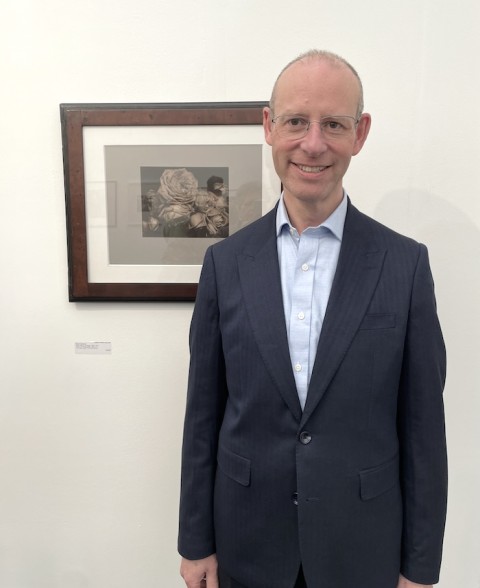
James Hyman, London. (Photo Courtesy: Daniella Dangoor).
Hyman continued, "We took a very, very conventional theme for Western painting and photography, which was the artist and model, but we gave it a bit of a twist, making it more contemporary with a section on Artist as Model, with works by Jo Spence, Rose Finn-Kelcey and others, and it ends with John Coplans looking at his body. We are being aware of gender because there's hardly a subject more gendered than artist and muse/model, so it was good to kind of break that up a little bit. We have one wall with photographs of Cecil Beaton of Giacometti in his studio, a Bill Brandt I have never seen, another print of--some vintage--previously unknown Henri Cartier-Bresson portraits of Matisse, the largest known print of Satiric Dancer by André Kertész, and some rare works by John Deakin. In addition, we are showing Edward Steichen's "Heavy Roses", a gorgeous print that was deaccessioned by MoMA as they had a duplicate, and some vintage prints by Vivian Maier, rare to see as she printed very little during her lifetime and most prints you see are posthumous."
One section that got a lot attention was devoted to vintage prints by Edith Tudor-Hart, usually described as an "Austrian-British photographer and spy for the Soviet Union." Hyman continued, "MuseumsETC just published a wonderful book focused on her time in Britain. I think people are now moving away from the notion of her as a communist spy and recruiter to her being a very good photographer. She gave up photography after she was investigated by MI5, which led to her having a breakdown. The work is very rare, and these are the only great prints I have come across during 25 years of collecting."
Hyman reported good sales, "It has been very positive. London doesn't have a huge collector base for photography, but we have done really well at the fair, so I'm very pleased."
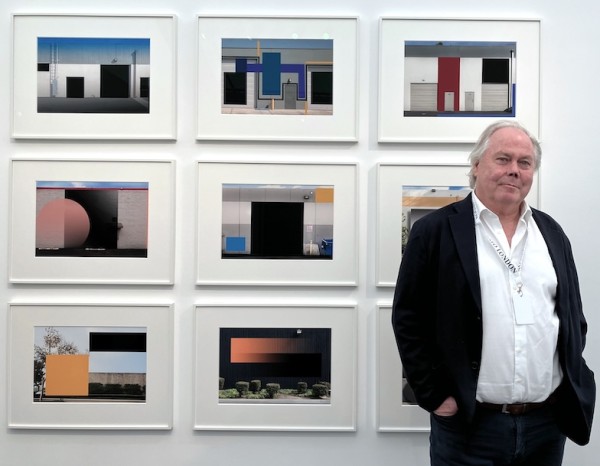
Timothy Persons, Persons Projects, Berlin.
Persons Projects, Berlin, presented works by Grey Crawford, Zofia Kulik, Nanna Hänninen, Jyrki Parantainen, Santeri Tuori and Niko Luoma. Timothy Persons told me, "We are concentrated on the conceptual side of photography, using the inside of the camera as opposed to what's in front of the camera. This year was great for us because we are showing Zofia Kulik and finally the Victoria & Albert Museum came on board for her because it took many years. The fair became the place where all the roads came together, to meet with the curators and the sponsors. We also had interest in her work from the Tate. She's already in the Pompidou and MoMA. For us, it has been a great year. Greg Crawford has done extremely well with his newest series and it's the first time we've exhibited these new works."
Persons noted changes at this year's edition of the fair, "Previously, we've always been able to sell larger works in London, but this year it's been more the smaller works and mid-sized pieces. Compared to Paris Photo this is more of a boutique fair. When I think of the big fairs we show at, the cost for exhibiting is so high, and then there's shipping and everything else. Photography itself isn't overpriced, but the big fairs are. Consequently, I think we will see more smaller fairs in the future so that we can compete."
Persons continued, "The older collectors still come to fairs but they have stopped buying. Some pass their works on to their children, but most of them don't keep the works, opting to sell instead. We need a whole new generation to come in and this is essential now for ALL fairs in the art market because it takes time for a generation of collectors to mature. Looking for good painting right now is hard, and if you find it, it's very expensive. There's an opportunity for photography, and that opportunity has to be introduced. It doesn't just come as a given. This fair is extremely positive in the sense that it offers a range of different positions where young collectors can come and get educated. How to interpret what they're looking at. What are the ideas? How do you bridge those ideas with other works in a portfolio? All this used to be done in galleries, but that doesn't happen now, because people don't go to galleries anymore. Because of that, Photo London is essential, because it is a foothold in one of the major capitals of the world. There are collectors here, it just takes time to reach out and touch them."
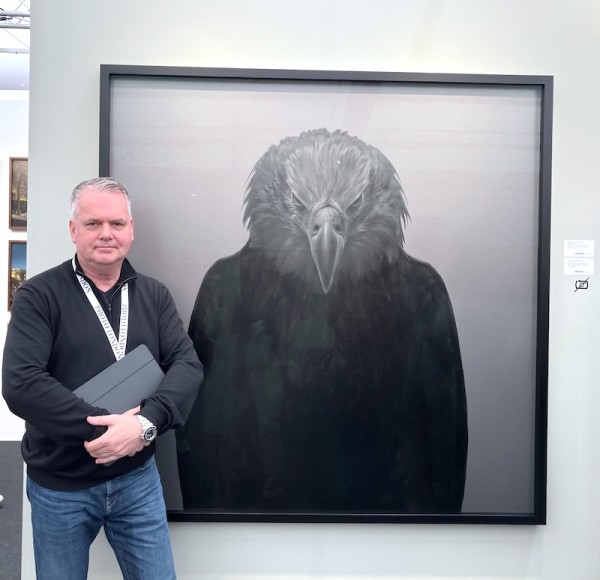
Hans van Enckevort, ARTITLEDCONTEMPORARY, Herpen.
ARTITLEDCONTEMPORARY, Herpen, Netherlands, showed bodies of work by two Australian artists, Dean West's "American West" and Tom Blachford.'s "Midnight Modern". Hans van Enckevort told me, "Just as in previous years, the opening day is the most important and that was when we achieved half our sales. The following days, people stroll in and out, take photos with their phones and there are very few conversations. Sure, we want to sell, but we also want to talk to people and share our passions. I just wish there would be a better audience, more engaged and better educated in photography."
Leading up to the fair last year, there was a serious effort by Candlestar and the then Director Kamiar Maleki to bring in a different audience, more specifically, buyers, and as a result, some exhibitors reported healthier sales that year. Hans van Enckevort reflected, "I really miss Kamiar because last year was so good for us. He really liked our stand and brought a lot of people to us. Many of them came back this year, but we haven't had an influx of new people and new buyers this year."
The gallery shows at four art fairs a year. "We try to be there for the young collectors as well as the important collectors. We do the affordable art fairs in London and we have learned that many collectors are tired of going to Frieze and the other the top fairs. They like to discover works by younger artists for prices up to 10,000 pounds."
The business is changing van Enckevort said, "Many galleries have stopped doing shows because people simply don't go to see them. For me and many others, it's about fairs, and we do about 14 a year. For some art fairs, the quantity of the tickets is the most important, because that generates the income. And for other art fairs, it's the quality that really counts. Personally, I would prefer to have 2,000 fewer visitors to Photo London if the ones that came were serious and had the intention to buy."
I returned to the Discovery section several times. Sule Gazioglu Gallery, Istanbul, presented two bodies of work by Annette Louise Solakoglu, the atmospheric "Ode to Istanbul" and "Botanica", on themes of impermanence and transformation. Sule Gazioglu told me, "This is the first time we exhibit at Photo London and we have been pleasantly surprised. There's a great variety of work at the fair and the staff is wonderful. The Discovery curator Charlotte Jansen and the Director Sophie Parker have been on top of everything. We have had a lot of great conversations, a lot of interest and we have sold well, and we have more than covered our costs. I think it was a blessing to be in the Discovery section. It seems to be the most vibrant part of the fair because people come to see work they haven't seen before. There has also been a sense of solidarity between the galleries, a real feeling of friendship, so it has been a great experience."

Benjamin Tischer of New Discretions, New York.
Further down in the Discovery section, Benjamin Tischer of New Discretions, New York., was showing edgier work, by Jordan Eagles, who explores the aesthetics and ethics of blood as an artistic media; Vivienne Maricevic, now in her 70s, who has documented aspects of erotica, sexuality and gender since her 20s; and Genesis P-Orridge, artist and musician best known as a member of the bands Throbbing Gristle and Psychic TV.
Tischer told me, "I had a gallery called Invisible Exports for 10 years and then I took a hiatus. New Discretions has been going five years. It's the first time at Photo London; in fact, the first time I have done a photography fair. Sophie Parker had seen Jordan Eagles' work at NADA Miami and finally convinced me to show here. The reception to the artists has been phenomenal and traffic has been consistent here every day which is unusual at a fair. As for sales, I'm still to get final decisions on two works by Jordan Eagles, a set of 23 prints by Vivienne Maricevic and two works by Genesis P-Orridge. If they all come through, I'll have hit the jackpot."
Some final thoughts. In The Art Newspaper, Director Sophie Parker was quoted as saying that she planned to "reward galleries that will take risks". I don't know how many of the exhibitors saw that quote, but some of those who did must have gulped for air. As the market has drifted into an era of low expectations, exhibiting at fairs poses a substantial financial risk and Photo London has always struggled with attracting buyers. Yes, I realize that she meant awarding galleries that show work of a non-decorative nature, but I can think of quite a few galleries that showed such work at the fair over the years and didn't sell a thing.
It brings me to something else and it concerns art fairs in general. In the last 25 years there has been a major push to smarten them up. A necessary move. I remember attending art fairs in 1990s where some booths looked like hastily arranged fire sales. Many exhibitors at art fairs now feel that the pendulum has swung too far the other way. That promoters increasingly regard themselves as curators rather than organizers of temporary places of business, with a responsibility on their part to bring in buyers. One thing for sure, the business model for dealers and galleries is getting harder and harder to navigate. While visitor numbers at many fairs are up, this rarely results in increased sales. One of the exhibitors at Photo London mentioned an idea to me, that exhibitors should get a share of the profits from ticket sales. As he put it, "I think that would be fair. After all, we are providing content and most visitors come to look, not to buy."
Michael Diemar is a London-based collector and consultant. He is also editor-in-chief of The Classic, a magazine about classic photography. He is a long-time writer about the photography scene, writing extensively for several Scandinavian photography publications, as well as for the E-Photo Newsletter and I Photo Central.
Photo London Moves to a Redeveloped Olympia in 2026
FOMU – Fotomuseum Antwerp: An Interview with Tamara Berghmans, Curator of the Collections Department
Summer Sale of over 4,000 Photographs on I Photo Central at 30% Discount
Italy Reduces VAT on Art and Photography Sales to 5%
Human Rights Lawyer to Defend Artist Gao Zhen, as China Holds the Artist's 7-Year-Old American Son
Some Recommended Vendors that We Have Worked with.


Share This